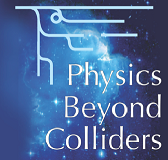Speaker
Description
In this talk we investigate scenarios for an experiment to measure the magnetic moment of the Λc and other charmed charged baryons at LHC top energies. In the last decade, the UA9 Collaboration has developed the technology and more recently used it to demonstrate that bent silicon crystals can efficiently steer the diffusive halo surrounding the circulating beam in LHC, up to 6.5 TeV energy. A scenario is described here to deflect the halo particles in the vicinity of an interaction region of LHC. The deflected particles should be kept in the vacuum pipe and will follow trajectories well distinct from those of the circulating beam core. By approaching to the beam a target that intercepts the channelled beam, well separated from the beam core, the deflected halo can be efficiently used for fixed-target physics. In particular, by directing the deflected halo into another bent crystal tightly packed with a short and dense target, located in the LHC pipe just before an existing detector, living baryons should be produced and their polarization may be measured from the analysis of the decay products. An additional downstream collimation setup is also required to intercept halo particles non-interacting with the target and debris from the target itself, in order to ensure that losses remain safely below quench limits of superconducting magnets, thereby allowing the possibility of fixed-target operation in parasitic mode. As an example, a preliminary optical layout compatible with the existing installations in IR8 is presented.
